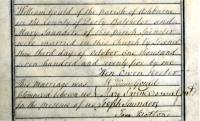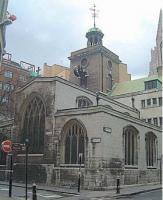
Nat Gould
His life and books
William Gould 1748-1795
| William Gould |
|---|
| Born: 1748 in Bakewell |
| Died: 1795 in Manchester |
| Father |
| Joseph Gould 1715-1777 |
| Mother |
| Ellen Gilbert 1722-1792 |
| Siblings |
| Anne Gould 1750-1753 |
| Thomas Gould 1752-1829 |
| Joseph Gould 1754-1821 |
| Nathaniel Gould 1756-1820 |
| John Gould 1759-1829 |
| Richard Gould 1761-1766 |
| George Gould 1763-1842 |
| Lydia Gould 1767-1822 |
| Spouse |
| Mary Saunders 1750-1829 m 3 October 1775 |
| Children |
| Mary Gould 1780-1850 |
| Harriet Gould 1781-1801 |
William Gould was born in 1748 and baptised at Bakewell on 20 May 1748.
He married Mary Saunders 1750-1829 of Durham at St Olave Hart Street church in the City of London on 3 October 1775.
This medieval church survived the Great Fire of London in 1666. The flames came within a hundred yards but then the wind changed direction (1).
After their marriage, William and Mary Gould lived at Barton House at Barton-on-Irwell near Manchester.
By 1787 William Gould was a merchant trading in Manchester in partnership with his brother Nathaniel Gould 1756-1820 as wholesale linen drapers and fustian manufacturers under the name of William and Nathaniel Gould & Co. (Fustian is a heavy woven cloth made from cotton or wool with linen, chiefly for menswear.) A third partner, Josiah Richardson Saunders 1753-1827, was the brother of Mary Saunders.
On 1 January 1787 the partnership was dissolved. Nathaniel Gould split off from the other two, and had his own warehouse. William Gould and Josiah Richardson Saunders had their warehouse in Smithy Door, a street in Manchester (2). By 1789 they had taken on another partner, William Glass. However, on 4 June 1789 this was dissolved and the business reverted to William Gould 1748-1795 and Josiah Richardson Saunders (3). Their partnership ended in 1795 when William Gould died.
William Gould and Mary his wife had two daughters :
Mary Gould 1780-1850. She was married to Dr Raphael Gillum 1769-1860 on 25 April 1816, and died on 28 August 1850 at the Green, Lea near Matlock in Derbyshire.
Harriet Gould 1781-1801. She was unmarried.
They may have also had a son, William Gould, who was baptised at St Ann's church in Manchester on 12 November 1777. If so, then he seems to have died before the decease of his mother on 1 November 1829, as the daughter Mary was the sole heiress.
(1) Unfortunately it was gutted by German bombs in 1941, but enough remained for restoration in 1954. It retains some of its ancient atmosphere that William and Mary Gould would have known, as would the diarist Samuel Pepys who is buried in its nave. King Haakon VII of Norway worshipped in the ruins until his return home in 1945. He led the re-dedication in 1954 when he laid a stone from Trondheim cathedral before the altar.
(2) The London Gazette dated 2 January 1787.
(3) The London Gazette dated 13 June 1789.


